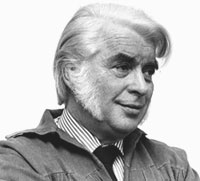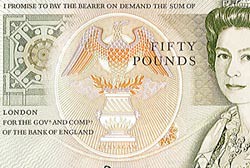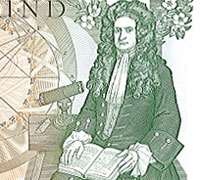
PREV ARTICLE
NEXT ARTICLE
FULL ISSUE
PREV FULL ISSUE
BANKNOTE DESIGNER HARRY ECCLESTON, 1923-2010
On May 26th The Times of London published this obituary of artist and banknote designer Harry Eccleston. Here are some excerpts.
-Editor
Subsequently, in 1958, Austin recruited Eccleston as the first artist designer to the Bank of England Printing Works, a position he held until 1983. He stayed on for three more years as a consultant until his retirement in 1986. The greater part of his time at the Bank was spent on two projects: the development of a computer engraving system to assemble notes more quickly than had been possible with previous, rather primitive, printing techniques; and, second, with Dr Ivor Stilitz, “perception research”, which was aimed at making it easier for the public to detect forgeries. “It was interesting to learn from the work how instinctively wrong one could be,” he said. “No one in the world had ever carried out such work which, of course, we gave to everyone.” In contrast to the highly decorative work necessary for banknotes, Eccleston's output as an original artist was much more simplified. (“The nuts and bolts of seeing” was what really interested him, he said). Figures, as they appeared in his earlier pictures, are invariably still — as if standing in a frieze. The big black-and-white prints, his main works, are more minimalist and almost abstract in their austerity. To read the complete article, see: Harry Eccleston: artist and banknote designer (www.timesonline.co.uk/tol/comment/obituaries/article7136284.ece)
The May 28 Coin Update newsletter led me (eventually) to another obituary at the Bank of England site - the images in this article are from that site.
-Editor
The Bank was saddened to learn that Harry Eccleston, a distinguished artist and the Bank's first full-time bank note designer, died on 30th April after a long illness. He was 87. Harry Eccleston joined the Bank in 1958 at the then recently-completed Debden Printing Works. He was recruited on the recommendation of Robert Austin who had been his college tutor and who was the designer of the 1960 £1 'C' bank note, the first Bank of England note to carry the Queen's portrait. Harry's artistic flair combined with his down-to-earth Black Country practicality prompted one General Manager of the Printing Works to write '....he was so imbued with the technical aspects that he was able to make them the building bricks of artistic creations...' . Harry went on to become the Bank's Artist Designer, a position that was created specially for him and which he held until his retirement in 1983, although he was retained by Debden as a note design consultant for a further three years.
Certainly the prism was included for reasons of historical accuracy and rightly so, but there remains the sneaking suspicion that it could also have been a mischievous inclusion. We will never know for certain but it did prompt an executive of Toblerone to write to the then Chief Cashier thanking the Bank for the free advertising. The Bank will always be grateful to Harry Eccleston. And his influence continues. The inspiration for the artwork in the Adam Smith £20 bank note came in part from the design of the £1 Isaac Newton note.
Harry Eccleston O.B.E. - Bank Note Designer
(www.bankofengland.co.uk/banknotes/harryeccleston.htm)
The Numismatic Bibliomania Society is a non-profit organization promoting numismatic literature. See our web site at coinbooks.org. To submit items for publication in The E-Sylum, write to the Editor at this address: whomren@gmail.com To subscribe go to: https://my.binhost.com/lists/listinfo/esylum All Rights Reserved. NBS Home Page Contact the NBS webmaster 
|
 Harry Eccleston worked for more than 25 years as a banknote designer at the Bank of England and was best known for the series D notes, issued in 1978 and the first fully pictorial series. Eccleston's portrait of the Queen was on the front of the notes and his drawings of Isaac Newton (£1), the Duke of Wellington (£5), Florence Nightingale (£10), Shakespeare (£20) and Christopher Wren (£50) were on the reverse.
Harry Eccleston worked for more than 25 years as a banknote designer at the Bank of England and was best known for the series D notes, issued in 1978 and the first fully pictorial series. Eccleston's portrait of the Queen was on the front of the notes and his drawings of Isaac Newton (£1), the Duke of Wellington (£5), Florence Nightingale (£10), Shakespeare (£20) and Christopher Wren (£50) were on the reverse.

